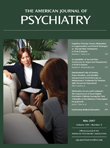Serotonin Transporter, Stressful Life Events, and Depression Severity
To The Editor: Recently, Gil Zalsman, M.D., and colleagues reported that lower expressing alleles (S+L G =S′) of the 5-HTTLPR polymorphism “independently predicted greater depression severity and predicted greater severity of major depression with moderate to severe life events compared with the higher expressing L A allele” ( 1 , p. 1588). We call into question the validity of these conclusions for several reasons.
First, the interaction analysis included 79 patients whereas the original cohort included 191 subjects. From Figure 1 and the data presented in the results section, we conclude that the frequencies of the L′L′, L′S′, and S′S′ genotypes in the group retained for the interaction analysis are 68.3% (54/79), 8% (6/79), and 24% (19/79), respectively. These proportions are highly different (χ 2 =46, df=2, p=0.000) from those reported in the entire cohort of depressed patients as presented in Table 1 of the article. No explanations for these differences or discussion of their consequences are provided. Additionally, these numbers indicate that some of the gene-by-environment strata have a very low cohort size (<5), which leads us to question the robustness of the results presented.
Second, simple calculations allowed us to make conservative estimates of the lower boundary of the Hamilton Depression Rating Scale (HAM-D) values for the S′L′ genotype for low (19.08) and high (22.74) stressful life events (available upon request). From these calculations and information provided in the text and in Figure 1, we concluded that patients with the S′S′ genotype have lower (at low stressful life events) or equivalent (at high stressful life events) HAM-D scores compared with those with the L′L′ genotype. Irrespective of stressful life events, patients with the L′S′ genotype have HAM-D scores that are at least equivalent (most likely higher if cohort sizes are not too unbalanced) when compared with patients with the L′L′ genotype. For these reasons, we question the rationale of grouping the S′S′ and S′L′ genotypes in a dominant model as shown in Figure 1 of the article by Dr. Zalsman and colleagues. Our estimates suggest that the reported interaction is most likely because of the fact that patients with the S′S′ genotype and low stressful life events have low HAM-D scores compared with patients with the L′L′ genotype exposed to low stressful life events while, at high stressful life events, patients with S′S′ and L′L′ genotypes have equivalent HAM-D scores. Finally, the significant effect of genotype on the severity of depression is primarily because of a small group (N=6) of patients with the S′L′ genotype, since patients with the S′S′ genotype have in fact the lowest severity scores, thus invalidating the claim that the lower expressing alleles of the 5-HTTLPR polymorphism in the serotonin transporter gene “predicted greater depression severity” (1, p. 1588). Disclosing the exact HAM-D values (SD) and number of patients in the six gene-by-environment strata and discussing the reasons for excluding more than one-half of the cohort would help readers to better interpret the results of this study.
1. Zalsman G, Huang YY, Oquendo MA, Burke AK, Hu XZ, Brent DA, Ellis SP, Goldman D, Mann JJ: Association of a triallelic serotonin transporter gene promoter region (5-HTTLPR) polymorphism with stressful life events and severity of depression. Am J Psychiatry 2006; 163:1588–1593Google Scholar



